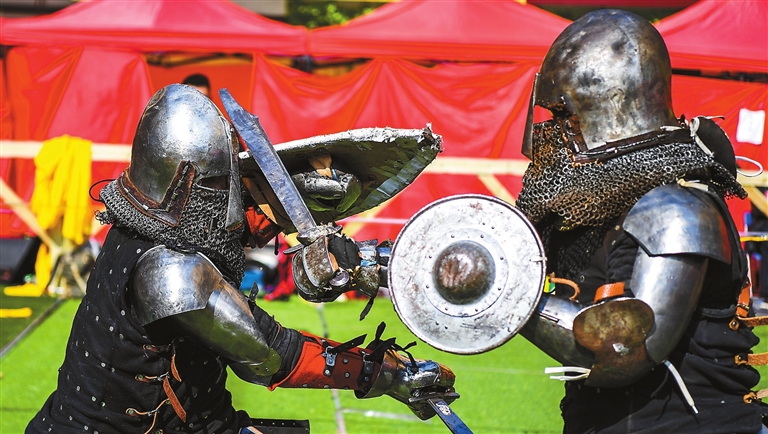

AT work, they are one of the thousands of commuters in the city. But after work, they put on their self-made suits of armor and go into battle, embracing ancient warriors and unleashing their passion on the field. They are Chinese Buhurt enthusiasts, who have represented their country in the international arena many times. Full-contact fighting in armor, also known as Buhurt, is a sport in which fighters wear all-round protective armor for close combat. The appearance of the armor must be as historically accurate as possible, and the weapons used need to be blunted and beveled. At present, more than 50 countries and regions participate in this sport worldwide. In 2016, China officially joined the international organization for full-contact fighting in armor — Battles of the Nations (BotN) — and a team was organized to participate in international competitions. There are currently six teams registered with more than 60 participants, among whom Team Half-ton from Shanghai ranked first in the Asia-Pacific region and top 10 in the world in 2020. It is not easy to participate in Buhurt competitions. Firstly, a fighter must have his own armor. According to Team Half-ton’s captain, known as Big Cat, the rules require participants’ armor to be representative of any style from the 13th to 17th centuries. After studying many ancient books, they decided to choose the armor style of the Ming Dynasty (1368-1644). In a studio located in Jiaxing, Zhejiang Province, the team members each worked on a specific aspect of the armor. Some were responsible for the design, and others were responsible for assembly, striving to find a perfect balance between historical accuracy and protection in competition. “We must wear armor that represents Chinese characteristics when we compete abroad. China is an ancient civilization, and the heavy weapons and armor on our body contain a glorious history,” Big Cat said. “Buhurt is a special sport. It is a combination of sport and culture. Therefore, the performance on the battlefield is not the most important factor, because as long as you compete tenaciously, you have won the respect of everyone. In addition to competition results, a cultural display is more essential. So, a large part of our energy will be spent on designing and assembling armor.” At first, the Authenticity Committee responsible for reviewing all participants’ equipment before the event ruled that Team Half-ton’s Ming-Dynasty vambrace was not sufficiently restored, and that there were some inconsistencies in its appearance. They recommended that the armor be improved to be as detailed as possible, in order to match with the historical features of the Ming Dynasty. The team members had to search for information overnight. Overcoming a lot of difficulties, the armor was finally forged before the event, and the results were good. The Historical Medieval Battle International Association gave a high evaluation after the picture was submitted. “For the first time, there was such a high degree of restoration in the competition, it looked like a perfect replica of Ming Dynasty armor,” Big Cat said proudly. The equipment was ready and the next step was training. Since most of the team members were usually busy with their regular jobs, they could only meet at weekends to rehearse battle formations and collaboration. Combining traditional Chinese martial arts and weapon techniques, the players established a set of training systems and methods that suited them, also consulting professional physical trainers and taking the training methods of mixed martial arts and Sanda for reference. Big Cat is an artistic designer in a games company, and he believes that his work has some intersection with Buhurt. “Since my work would involve some martial arts and war content for nations in various historical periods, I had opportunities to learn about the use of different weapons in various countries through Buhurt, which also benefited my work,” he said. He also admitted that work and hobbies cannot be completely conjoined. After all, Buhurt requires a lot of time for training and overseas competitions. For Big Cat and his teammates, Buhurt has taken up an important part of life, and they are willing to pay for their dream. Big Cat said “as an individual, work is a means of earning a living, but Buhurt is a spiritual pursuit. You can only try your best to coordinate between these two things.” (Xinhua) | 
